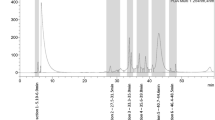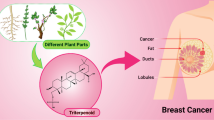Abstract
Thyroid cancer is the most widespread endocrine malignant cancer and its worldwide occurrence rates are swiftly mounting more pressure in the research institutions. Even though the transience of thyroid cancer is comparatively short, its rate of reappearance is moderately elevated, which is a major cause of the incurable disease of the thyroid gland. Consequently, we used natural component which restrains the cancer cell growth by amending precise molecular mechanisms. In this current study, we assessed sesame, which is a very active substance that inhibits cell proliferation by modulation of JAK/STAT-3 signaling in thyroid cancer cell lines (FTC-133). Results showed that sesame triggers cytotoxicity, ROS production and apoptosis in FTC-133 cell lines by time-dependent approach. Furthermore, Signal Transducer and Activating Transcription (STAT-3) is a novel oncogenic transcriptional factor which normalizes apoptosis and proliferation. The reticence of STAT-3 transcription was measured as an innovative approach to hamper thyroid cancer cell growth. In this current study, we established that sesame deactivates STAT-3 translocation, thereby reducing the elevated expression of, cyclin-D1, Bcl-2 and diminished expression of Bax, caspase-9 and 3 in FTC-133 cell lines. Conclusively, sesame hampers thyroid cell expansion and initiates apoptosis by hindering STAT-3 translocation.
Similar content being viewed by others
References
La Vecchia, C., M. Malvezzi, C. Bosetti, W. Garavello, P. Bertuccio, F. Levi, and E. Negri (2015) Thyroid cancer mortality and incidence: a global overview. Int. J. Cancer. 136: 2187–2195.
Hershman, J. M. (2017) The increased incidence of thyroid cancer is worldwide. Clin. Thyroidol. 29: 11–12.
Kitahara, C. M. and J. A. Sosa (2016) The changing incidence of thyroid cancer. Nat. Rev. Endocrinol. 12: 646–653.
Sprague, B. L., S. Warren Andersen, and A. Trentham-Dietz (2008) Thyroid cancer incidence and socioeconomic indicators of health care access. Cancer Causes Control. 19: 585–593.
Cohen, Y., M. Xing., E. Mambo, Z. Guo, G. Wu, B. Trink, U. Beller, W. H. Westra, P. W. Ladenson, and D. Sidransky (2003) Braf mutation in papillary thyroid carcinoma. J. Natl. Cancer Inst. 95: 625–627.
Kimura, E. T., M. N. Nikiforova, Z. Zhu, J. A. Knauf, Y. E. Nikiforov, and J. A. Fagin (2003) High prevalence of braf mutations in thyroid cancer: genetic evidence for constitutive activation of the ret/ptc-ras-braf signaling pathway in papillary thyroid carcinoma. Cancer Res. 63: 1454–1457.
Hou, P., D. Liu, Y. Shan, S. Hu, K. Studeman, S. Condouris, Y. Wang, A. Trink, A. K. El-Naggar, G. Tallini, V. Vasko, and M. Xing (2007) Genetic alterations and their relationship in the phosphatidylinositol 3-kinase/akt pathway in thyroid cancer. Clin. Cancer Res. 13: 1161–1170.
Ai, T., Z. Wang, M. Zhang, L. Zhang, N. Wang, W. Li, and L. Song (2012) Expression and prognostic relevance of stat3 and cyclin d1 in non-small cell lung cancer. Int. J. Biol. Markers. 27: e132–e138.
Birner, P., K. Toumangelova-Uzeir, S. Natchev, and M. Guentchev (2010) STAT3 tyrosine phosphorylation influences survival in glioblastoma. J. Neurooncol. 100: 339–343.
Liu, X., Z. He, C. H. Li, G. Huang, C. Ding, and H. Liu (2012) Correlation analysis of JAK-STAT pathway components on prognosis of patients with prostate cancer. Pathol. Oncol. Res. 18: 17–23.
Schoppmann, S. F., B. Jesch, J. Friedrich, G. Jomrich, F. Maroske, and P. Birner (2012) Phosphorylation of signal transducer and activator of transcription 3 (stat3) correlates with her-2 status, carbonic anhydrase 9 expression and prognosis in esophageal cancer. Clin. Exp. Metastasis. 29: 615–624.
Chen, Y., J. Wang, X. Wang, X. Liu, H. Li, Q. Lv, J. Zhu, B. Wei, and Y. Tang (2013) Stat3, a poor survival predicator, is associated with lymph node metastasis from breast cancer. J. Breast Cancer. 16: 40–49.
Groner, B., P. Lucks, and C. Borghouts (2008) The function of stat3 in tumor cells and their microenvironment. Semin. Cell Dev. Biol. 19: 341–350.
Pilati, C., M. Amessou, M. P. Bihl, C. Balabaud, J. T. Nhieu, V. Paradis, J. C. Nault, T. Izard, P. Bioulac-Sage, G. Couchy, K. Poussin, and J. Zucman-Rossi (2011) Somatic mutations activating stat3 in human inflammatory hepatocellular adenomas. J. Exp. Med. 208: 1359–1366.
Rebouissou, S., M. Amessou, G. Couchy, K. Poussin, S. Imbeaud, C. Pilati, T. Izard, C. Balabaud, P. Bioulac-Sage, and J. Zucman-Rossi (2009) Frequent in-frame somatic deletions activate gp130 in inflammatory hepatocellular tumours. Nature. 457: 200–204.
Albi, E., F. Curcio, R. Spelat, R. Lazzarini, E. Loreti, I. Ferri, F. S. Ambesi-Impiombato (2012) The thyroid lobes: The different twins. Arch. Biochem. Biophys. 518: 16–22.
Subramaniam, A., M. K. Shanmugam, E. Perumal, F. Li, A. Nachiyappan, X. Dai, S. N. Swamy, K. S. Ahn, A. P. Kumar, B. K. Tan, K. M. Hui, and G. Sethi (2013) Potential role of signal transducer and activator of transcription (STAT-3) signaling pathway in inflammation, survival, proliferation and invasion of hepatocellular carcinoma. Biochim. Biophys. Acta. 1835: 46–60.
Gurbuz, V., E. Konac, N. Varol, A. Yilmaz, S. Gurocak, and S. Sozen (2014) Effects of AG490 and S3I-201 on regulation of the JAK/STAT3 signaling pathway in relation to angiogenesis in TRAIL-resistant prostate cancer cells in vitro. Oncol. Lett. 7: 755–763.
Aggarwal, B. B. and S. Shishodia (2006) Molecular targets of dietary agents for prevention and therapy of cancer. Biochem. Pharmacol. 71: 1397–1421.
Al Zaid Siddiquee, K. and J. Turkson (2008) STAT3 as a target for inducing apoptosis in solid and hematological tumors. Cell Res. 18: 254–267.
Anilkumar, K., A. Pal, F. Khanum, and A. Bawa (2010) Nutritional, medicinal and industrial uses of sesame (sesamum indicum L.) seeds — an overview. Agric. Conspec. Sci. 75: 159–168.
Komar, R., S. Happyniar., and I. Fidrianny (2018) Antioxidant potential of two varieties of Sesamum indicum L. collected from Indonesia. J. Taibah University Medical Sci. 13: 211–218.
Hsu, D. Z., C. T. Liu., P. Y. Chu, Y. H. Li, S. Periasamy, and M. Y. Liu (2013) Sesame oil attenuates ovalbumin-induced pulmonary edema and bronchial neutrophilic inflammation in mice. Biomed Res. Int. 2013: 905670.
Xu, P., F. Cai, X. Liu, and L. Guo (2015) Sesamin inhibits lipopolysaccharide-induced proliferation and invasion through the p38-MAPK and NF-.B signaling pathways in prostate cancer cells. Oncol. Rep. 33: 3117–3123.
Dar, A. A. and N. Arumugam (2013) Lignans of sesame: purifcation methods, biological activities and biosynthesis—a review. Bioor. Chem. 50: 1–10.
Smith, D. E. and J. W. Salerno (2001) Selective growth inhibition of a human malignant melanoma cell line by sesame oil in vitro. Prostaglandins Leukot. Essent. Fatty Acids. 46: 145–150.
Reshma, M. V., C. Balachandran, C. Arumughan, A. Sunderasan, D. Sukumaran, S. Thomas, and S. S. Saritha (2010) Extraction, separation and characterisation of sesame oil lignan for nutraceutical applications. Food Chem. 120: 1041–1046.
Zhou, J. G., L. L. He, X. F. Ding, Q. Q. Yuan, J. X. Zhang, S. C. Liu, and G. Chen (2016) Combinatorial antitumor effect of rapamycin and β-Elemene in follicular thyroid cancer cells. Biomed. Res. Int. 2016: 6723807.
Yi, J. W., J. Y. Park, J. Y. Sung, S. H. Kwak, J. Yu, J. H. Chang, J. H. Kim, S. Y. Ha, E. K. Paik, W. S. Lee, S. J. Kim, K. E. Lee, and J. H. Kim (2015) Genomic evidence of reactive oxygen species elevation in papillary thyroid carcinoma with Hashimoto thyroiditis. Endocr. J. 62: 857–877.
Kasibhatla, S., G. P. Amarante-Mendes, D. Finucane, T. Brunner, E. Bossy-Wetzel, and D. R. Green (2006) Acridine orange/ethidium bromide (AO/EB) staining to detect apoptosis. Cold Spring Harb. Protoc. 2006: pdb.prot4493.
Yang, D., X. Zhang, W. Zhang, and T. Rengarajan (2018) Vicenin-2 inhibits Wnt/β-catenin signaling and induces apoptosis in HT-29 human colon cancer cell line. Drug Des. Devel. Ther. 12: 1303–1310.
Parker, S. L., T. Tong., S. Bolden, and P. A. Wingo (1997) Cancer statistics, 1997. CA Cancer J. Clin. 47: 5–27.
Haugen, B. R. (1999) Management of the patient with progressive radioiodine non-responsive disease. Semin. Surg. Oncol. 16: 34–41.
Bopitiya, D. and T. Madhujith (2015) Antioxidant activity and total phenolic content of sesame (Sesamum indicum L.) seed oil. Trop. Agric. Res. 24: 296–302.
Galadari, S., A. Rahman, S. Pallichankandy, and F. Thayyullathil (2017) Reactive oxygen species and cancer paradox: To promote or to suppress? Free Radic. Biol. Med. 104: 144–164.
Naczk, M. and F. Shahidi (2004) Extraction and analysis of phenolics in food. J. Chromatogr. A. 1054: 95–111.
Lee, S. W., M. K. Jeung, M. H. Park, S. Y. Lee, and J. H. Lee (2010) Effects of roasting conditions of sesame seeds on the oxidative stability of pressed oil during thermal oxidation. Food Chem. 118: 681–685.
Yokota, T., Y. Matsuzaki, M. Koyama, T. Hitomi, M. Kawanaka, M. Enoki-Konishi, Y. Okuyama, J. Takayasu, H. Nishino, A. Nishikawa, T. Osawa, and T. Sakai (2007) Sesamin, a lignan of sesame, down-regulates cyclin D1 protein expression in human tumor cells. Cancer Sci. 98: 1447–1453.
Guschin, D., N. Rogers, J. Briscoe, B. Witthuhn, D. Watling, F. Horn, S. Pellegrini, K. Yasukawa, P. Heinrich, and G. R. Stark (1995) A major role for the protein tyrosine kinase JAK1 in the JAK/STAT signal transduction pathway in response to interleukin-6. EMBO J. 14: 1421–1429.
Denley, S. M., N. B. Jamieson, P. McCall, K. A. Oien, J. P. Morton, C. R. Carter, J. Edwards, and C. J. McKay (2013) Activation of the IL-6R/Jak/stat pathway is associated with a poor outcome in resected pancreatic ductal adenocarcinoma. J. Gastrointest Surg. 17: 887–898.
Hanahan, D. and R. A. Weinberg (2000) The hallmarks of cancer. Cell. 100: 57–70.
Yip, K. W. and J. C. Reed (2008) Bcl-2 family proteins and cancer. Oncogene. 27: 6398–406.
Liu, Y., L. Tong, Y. Luo, X. Li, G. Chen, and Y. Wang (2018) Resveratrol inhibits the proliferation and induces the apoptosis in ovarian cancer cells via inhibiting glycolysis and targeting AMPK/mTOR signaling pathway. J. Cell Biochem. 1–11.
Author information
Authors and Affiliations
Corresponding author
Additional information
Publisher’s Note Springer Nature remains neutral with regard to jurisdictional claims in published maps and institutional affiliations.
Rights and permissions
About this article
Cite this article
Ma, Y., Karunakaran, T., Veeraraghavan, V.P. et al. Sesame Inhibits Cell Proliferation and Induces Apoptosis through Inhibition of STAT-3 Translocation in Thyroid Cancer Cell Lines (FTC-133). Biotechnol Bioproc E 24, 646–652 (2019). https://doi.org/10.1007/s12257-019-0151-1
Received:
Revised:
Accepted:
Published:
Issue Date:
DOI: https://doi.org/10.1007/s12257-019-0151-1




